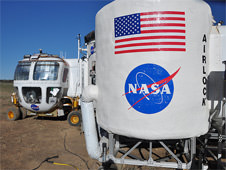[/caption]
Editor’s note: This guest post was written by Andy Tomaswick, an electrical engineer who follows space science and technology.
If humans are planning on spending any significant amount of time on the surface of another planet in the solar system, they’re going to need a specially made habitat to live in. Developing a prototype of that habitat is the goal of the NASA Advanced Exploration Systems Habitation Systems project, which sponsors the annual eXploration Habitat (X-Hab) challenge. To achieve this, NASA and the National Space Grant Foundation solicited ideas for module design ideas from universities back in March. On May 30th, the X-Hab challenge organizers selected 5 university teams to participate in the competition. The winning teams and their research concepts are:
California State Polytechnic University – “Vertical Habitability Layout and Fabrication Studies”
Oklahoma State University- “Horizontal Habitability Layout Studies”
Texas A&M University – “Wireless Smart Plug for DC Power”
University of Alabama at Huntsville – “Design and Development of a Microgravity Random Access Stowage and Rack System”
University of Colorado at Boulder – “Remote Plant Food Production Capability”
The teams are comprised primarily of undergraduate students, which NASA hopes will help train the next generation of scientists and engineers to work on future projects. They have a challenging journey ahead of them, as their selection is the first step in a process that will see the teams developing, delivering and testing their concepts within a year. The technologies from this year will add to the technologies from previous years, giving NASA a growing collection of ideas to draw from. With the continued success of the program, NASA’s next habitation module might primarily be designed by students.
See this website for more information.
Sources :
NASA , eXploration Habitat (X-Hab) Academic Innovation Challenge 2013 “” Accessed 6-4-12

